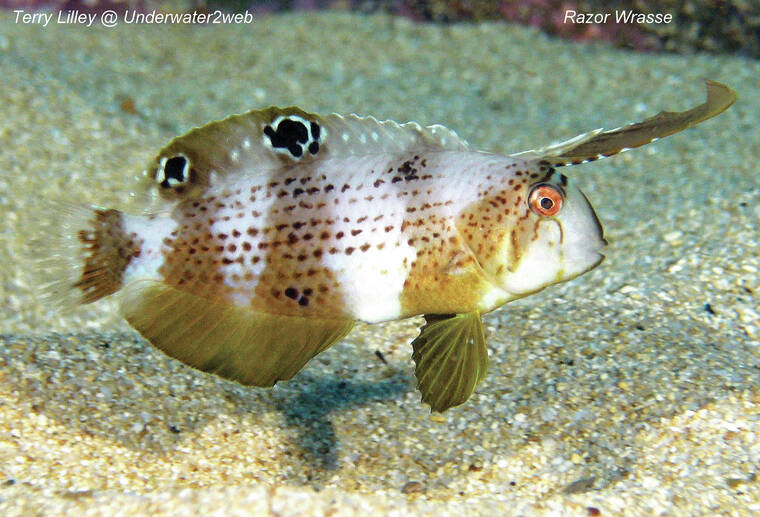This 5- to 10-inch long wrasse is quite common in Hawai‘i but most divers don’t see them because they live out on the sandy seafloor. The adults are solid grey and their Hawaiian name means “sharp forehead.” The young ones are a beautiful golden brown and have a huge dorsal filament fin that sticks out from the top of their head like a unicorn.
This 5- to 10-inch long wrasse is quite common in Hawai‘i but most divers don’t see them because they live out on the sandy seafloor. The adults are solid grey and their Hawaiian name means “sharp forehead.” The young ones are a beautiful golden brown and have a huge dorsal filament fin that sticks out from the top of their head like a unicorn.
What is so unique about laenihi is its ability to literally swim under the sand! When the fish swims a few inches above the sandy seafloor it moves from side to side and minick’s a dead leaf floating in the current. I often point this fish out to divers and they will say “what am I looking at” as they just see what they think are a few dead leaves floating above the sand and moving with the surge of the surf.
This fish has two ways to escape predators. Looking like a leaf usually works to not attract attention but living out on the open sand can be dangerous because there is no reef to hide in. If you follow this amazing creature while diving it will take you on a wild tour of its sandy home then just disappear! This happened so fast that I had to film it and look at the footage in slow motion to see where laenihi went.
The Peacock Razor Rasse is territorial and there are usually several females and one male on a sandy part of the seafloor every 50 feet or so. They spend time digging a hole in the sand then filling the hole back up with loose sand.
When a predator gets too close the fish dives into the sand in a split second and can even swim under the sand for a short distance. I have spent hours underwater watching this disappearing act and have even tried digging the fish up after it buried itself but I have never been successful at finding one!
In each of the sandy territories laenihi may have three or four soft sandy patches it has prepared so it can dive into. They can’t just dive into the sand anywhere as there may be a rock right under the sand and it would be a disaster to smash into it. It took me years to finally get a good picture of laenihi because they are so fast so I finally learned how to spot their fish made sand traps. I laid right above the sand trap then chased one of them away from its home and just waited until it came back and dove into the sand right in front of the camera.
You can see leaenihi in action in my movie The Worlds Guide To Hawaiian Reef Fish up on my underwater educational web page at underwater2web.com.
•••
Terry Lilley is a marine biologist living in Hanalei Kaua‘i and co-founder of Reef Guardians Hawai‘i, a nonprofit on a mission to provide education and resources to protect the coral reef. To donate to Reef Guardians Hawaii go to reefguardianshawaii.org.



